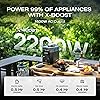







Ready to go? Add this product to your cart and select a plan during checkout. Payment plans are offered through our trusted finance partners Klarna, PayTomorrow, Affirm, Afterpay, Apple Pay, and PayPal. No-credit-needed leasing options through Acima may also be available at checkout.
Learn more about financing & leasing here.
Non-returnable. Transportation of this item is subject to hazardous materials regulation
View our full returns policy here.
Style: DELTA 2
Features
Brand: EF ECOFLOW
Wattage: 1800 watts
Power Source: Solar Powered
Recommended Uses For Product: Camping
Item Weight: 27 Pounds
Voltage: 120 Volts
Output Wattage: 1800 Watts
Special Feature: Plug and play home backup power, Or go green without sacrificing speed, Huge AC output, Expandable capacity, 7x Faster AC charging See more
Included Components: DC5521 to DC5525 Cable, User Manual, DELTA2 Power Station, AC Charging Cable, Car Charging Cable
Color: Black
Brand: EF ECOFLOW
Wattage: 1800 watts
Power Source: Solar Powered
Recommended Uses For Product: Camping
Item Weight: 27 Pounds
Voltage: 120 Volts
Output Wattage: 1800 Watts
Special Feature: Plug and play home backup power, Or go green without sacrificing speed, Huge AC output, Expandable capacity, 7x Faster AC charging
Included Components: DC5521 to DC5525 Cable, User Manual, DELTA2 Power Station, AC Charging Cable, Car Charging Cable
Color: Black
Product Dimensions: 15.7"L x 8.3"W x 11.3"H
Model Name: DELTA 2
Engine Type: inverter
Total Power Outlets: 15
Frequency: 60 Hz
Engine Power Maximum: 2700 Watts
Starting Wattage: 2700 Watts
Running Wattage: 1800 Watts
UPC: 842783119520
Manufacturer: EF ECOFLOW
Item Weight: 27 pounds
Item model number: EFD330



















